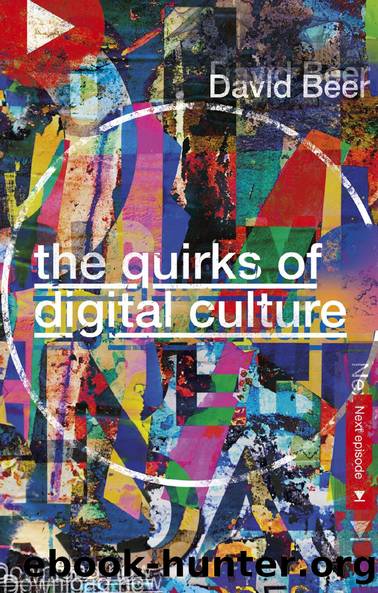The Quirks of Digital Culture by David Beer

Author:David Beer [Beer, David]
Language: eng
Format: epub
Tags: Social Science, Media Studies, Language Arts & Disciplines, Communication Studies, Popular Culture, Computers, Computerized Home & Entertainment, Anthropology, Cultural & Social
ISBN: 9781787699137
Google: jPKyDwAAQBAJ
Publisher: Emerald Group Publishing
Published: 2019-10-11T05:30:06+00:00
SOCIAL MEDIA AND MEMORIES
Social media has changed. Following more than a decade of popular use, the information in our Facebook, Instagram or Twitter profiles is no longer just about the current moment or instant connections. Instead of simply broadcasting our thoughts and actions as they happen, these platforms have become a biographical archive113 of our lives, storing our photos and recording where we went and who we were with. The result of this archiving is that social media is taking on a new role in the way that we remember.
Even the most ephemeral social media platform, Snapchat, has now joined in this archiving process with the launch of its Memories feature in 2016.114 Before that point, Snapchatâs unique selling point has been that its picture messages were designed to disappear within seconds of being sent. This additional function allows users to build a âpersonal collection of your favourite momentsâ (i.e. archive images taken with your phone), which can then be kept private or shared.
As I have mentioned, Mike Featherstone has argued that humans have a powerful âimpulseâ to archive.115 We even see this in the history of the modern state, which sought to capture and record116 large amounts of information about peoplesâ lives. Smartphones and the internet mean that we can now satisfy this drive at the level of our everyday lives. Snapchatâs Memories feature seems to exactly fit with this impulse.
So if we rely more and more on social media to archive our memories, how will it shape how we remember? As time passes, more of peopleâs lives will be captured in these profiles. And when we want to remember our lives and the lives of the people we connect with, we will inevitably turn to the data stored in these social media archives. Our memories might then be shaped by the types of things that we choose to include in our visible social media profiles, or even in less visible spaces protected by our privacy settings117 (as included in the Memories feature).
Featherstone has also argued that an archive, as a space in which documents are captured and classified, is âa place for creating and reworking memoryâ.118 What we put in our social profiles and how we classify it will then shape what is remembered and how those memories are recalled. For example, the tags and labels we add to photos stored online will affect what we later recall about the occasion and the people who were there. Of course, our social media profiles are filtered versions of our lives119 that display a managed persona,120 so they are likely to create an archive of certain types of favourable memories that fit with this persona.
As we come increasingly to rely on social media as an archive, the way we add to it will also inevitably change. We wonât just be posting in the moment but will also have an eye on the future. We will be thinking about the way that our content will be received and will imagine how it will be drawn upon to remember our past from some unknown future moment.
Download
This site does not store any files on its server. We only index and link to content provided by other sites. Please contact the content providers to delete copyright contents if any and email us, we'll remove relevant links or contents immediately.
Cecilia; Or, Memoirs of an Heiress — Volume 1 by Fanny Burney(32434)
Cecilia; Or, Memoirs of an Heiress — Volume 2 by Fanny Burney(31871)
Cecilia; Or, Memoirs of an Heiress — Volume 3 by Fanny Burney(31852)
The Lost Art of Listening by Michael P. Nichols(7406)
Asking the Right Questions: A Guide to Critical Thinking by M. Neil Browne & Stuart M. Keeley(5632)
We Need to Talk by Celeste Headlee(5542)
On Writing A Memoir of the Craft by Stephen King(4863)
Dialogue by Robert McKee(4321)
Pre-Suasion: A Revolutionary Way to Influence and Persuade by Robert Cialdini(4145)
I Have Something to Say: Mastering the Art of Public Speaking in an Age of Disconnection by John Bowe(3840)
Elements of Style 2017 by Richard De A'Morelli(3307)
The Book of Human Emotions by Tiffany Watt Smith(3238)
Fluent Forever: How to Learn Any Language Fast and Never Forget It by Gabriel Wyner(3028)
Name Book, The: Over 10,000 Names--Their Meanings, Origins, and Spiritual Significance by Astoria Dorothy(2939)
Good Humor, Bad Taste: A Sociology of the Joke by Kuipers Giselinde(2903)
Why I Write by George Orwell(2874)
The Art Of Deception by Kevin Mitnick(2736)
The Grammaring Guide to English Grammar with Exercises by Péter Simon(2706)
Ancient Worlds by Michael Scott(2623)
